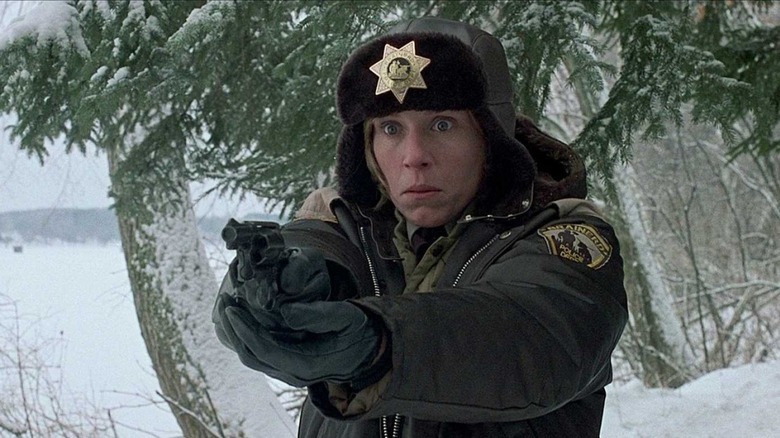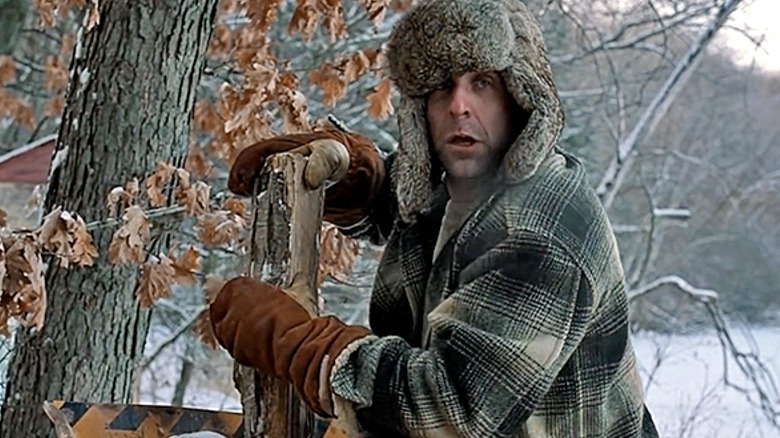The Coen Brothers' Fargo Was (Very Loosely) Based Around A Real Crime
Despite how the title card for "Fargo" confidently states that "This is a true story," the Coen brothers' classic crime thriller is, in fact, a work of fiction. That's common knowledge at this point, but the Coens were inspired by actual real-world events when constructing the story. Instead of an exact retelling of a true crime story, the screenplay is a bit of a hodgepodge of elements taken from several news events with a good dose of the Coens' own original input. Strangely enough, the notoriously grisly woodchipper scene, which seems like the most fabricated part of the whole tale, is actually the part of the film that is closest to reality.
One inspiration, according to an interview with The Huffington Post, was John McNamara, who defrauded $6 billion from General Motors. Another possible influence was the case of St. Paul attorney T. Eugene Thompson, who put a hit out on his wife in order to collect her life insurance money. The location of the crime in Minnesota and the Coen-esque nature of the grim debacle was probably what led people to believe it served as the basis for "Fargo," though Joel Coen has claimed he never heard of the case. The most definitively factual connection, though, is the murder of Helle Crafts.
The woodchipper murder
On November 18, 1986, flight attendant Helle Crafts disappeared after arriving home in Newtown, Connecticut, from a trip to West Germany. She had been fighting with her husband Richard ever since she hired a private investigator and discovered that he had been having an affair with another woman. Richard had not taken her plans for divorce very lightly and she was starting to warn her friends about his increasingly violent nature, so suspicions against Richard immediately rose as soon as Helle was nowhere to be found. At first, Richard claimed she was visiting her mother in Denmark, but over the weeks his story shifted to claiming she was in the Canary Islands. Still, local Newtown police knew Richard through a volunteer program and dismissed any accusations, so it wasn't until Connecticut State Police showed up the day after Christmas that Richard's crimes surfaced.
A search of Richard's home revealed a piece of bedroom carpet missing and a blood smear on the mattress, while an investigative interview with the nanny revealed that the blood was also on the part of the carpet that was no longer there. In addition, credit card receipts listed Richard's purchase of a freezer, bed sheets, a comforter, and, most chillingly, a woodchipper and a chainsaw. Finally, a snowplow driver told the police that he saw a man with a woodchipper near Lake Zoar, a reservoir on the Housatonic River. An investigation of the site revealed a chainsaw blade along with blood and pieces of human bone and tissue fragments, over 2,660 strands of blonde hair, a fingernail with pink nail polish, and the crown of a tooth that matched Helle's dental records.
An (un)ordinary thriller
Despite all this evidence, the lack of a physical corpse resulted in a drawn-out trial, and Richard Crafts wasn't convicted until 1989, the first occurrence of a guilty murder case in Connecticut without a body present. Although the Coens were initially vague in drawing any parallels to true crime events, the special edition DVD does confirm that the Crafts case inspired the woodchipper scene at the end of the film.
However, in an interview with Cinephilia & Beyond, Joel and Ethan Coen stated that whatever real-life stories they referenced in writing "Fargo" is purely surface value:
"In its general structure, the film is based on a real event, but the details of the story and the characters are fictional. We were not interested in making a documentary film, and we did no research about the nature of the murders or the events connected to them. But in warning viewers that we had found our inspiration from a real story, we were preparing them to not view the film like an ordinary thriller."
No other aspects of the woodchipper murder were actually included in "Fargo" besides the woodchipper itself and perhaps the general idea of a marriage gone sour. The incident was merely one part of the larger puzzle that became "Fargo," itself a story of interconnected bad decisions, bad instincts, and bad luck. The Coens pieced together disparate elements of truth and fiction to create a strange, borderline absurd world that also feels uncomfortably realistic.


